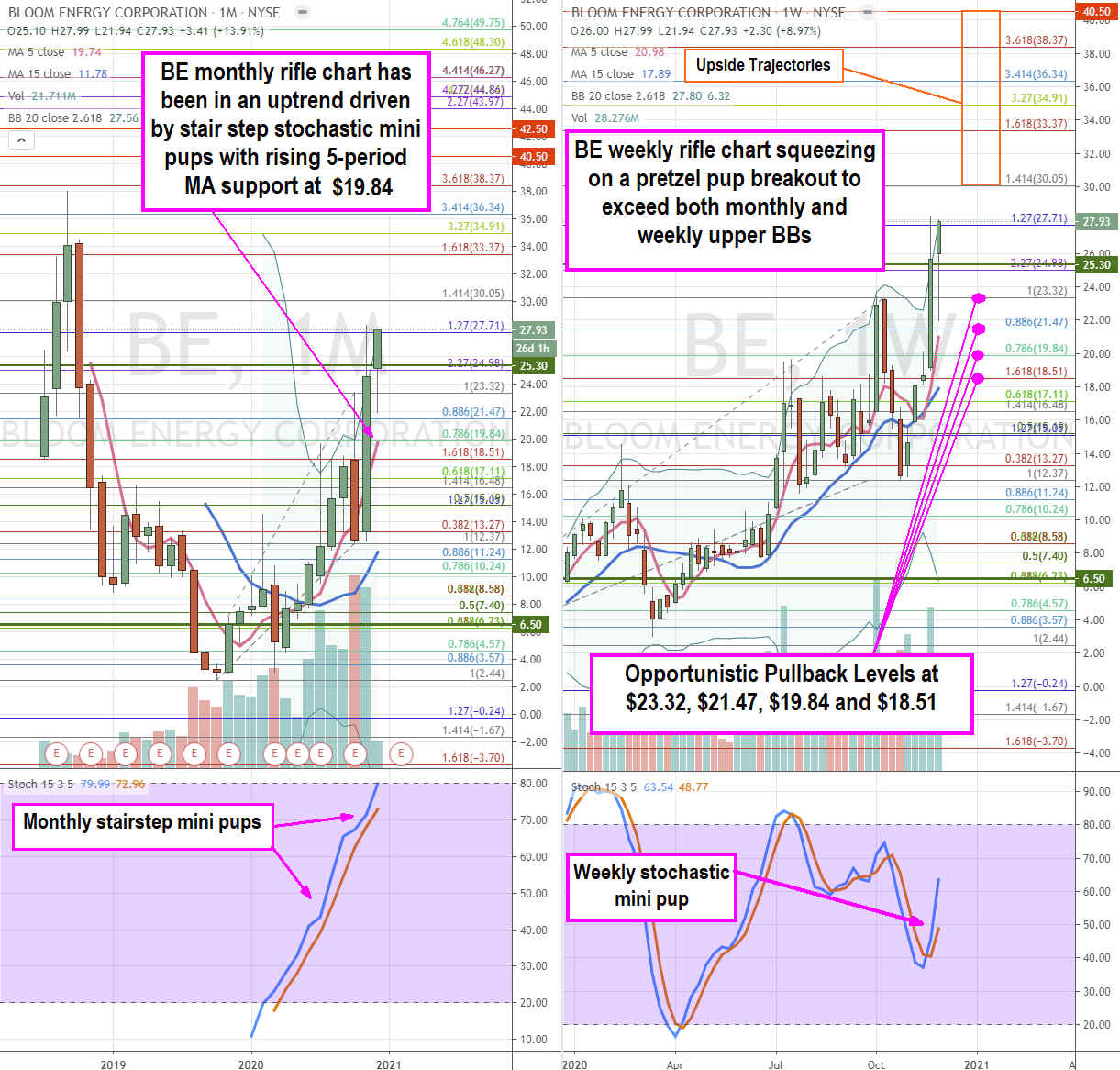Solid-oxide fuel cell systems provider
Bloom Energy NYSE: BE stock has seen a resurgence from the
electric vehicle (EV) momentum. As momentum and money flow frantically shifts from EVs to EV fueling, power sources and materials, shares of former momentum flyers
FuelCell Energy, Inc. NASDAQ: FCEL,
Plug Power NASDAQ: PLUGand
Ballard Power Systems NASDAQ: BLDP have all seen price inflation. Bloom Energy Servers convert various types of fuel to electricity through a proprietary electrochemical process without combustion. Each Energy Server produces 200 to 300 kilowatts of “always on“ clean energy that can be stacked like building blocks to form power grinds. The applications exceed far beyond EVs but it’s the EV mania that is driving up shares to outperform the benchmark
S&P 500 index NYSEARCA: SPY.
Money (and momentum) has spread into the heavily speculated EV stocks continued to flow into battery, materials and battery charging stocks. Seasoned traders (old-timers) may remember FCEL trading with them during the first alternative energy boom, before the bust cycle. With the latter trading in the $20s, shares of FuelCell would appear to be a laggard under $10. Nimble traders can monitor the price action of the peers to gauge the sentiment while watching FCEL shares for opportunistic pullback price levels to trade reversions. It’s important to remember that narrative is fueling the momentum enabling these stocks to trade ahead of the actual fundamentals. In other words, don’t buy into or believe the hype. These are still very much developmental companies selling the ‘dream’. Prudent investors should opt to wait for much deeper pullbacks to consider exposure, while nimble traders can ride the momentum bounces off pullbacks.
Q3 FY 2020 Earnings Release
On Oct. 29, 2020, Bloom Energy reported its fiscal third-quarter 2020 results for the quarter ending July 2020. The Company reported an adjusted earnings-per-share (EPS) loss of (-$0.04) versus consensus analyst estimates for EPS loss of (-$0.14), a $0.10 beat. Revenues fell (-10.7%) year-over-year (YOY) to $200.31 million missing analyst estimates by (-$26.37 million).
Conference Call Takeaways
Bloom Energy CEO and Co-Founder, K.R. Sridhar, stated “We have reduced debt, extended maturities, reduced our interest expense, and added cash to our balance sheet.” Sridhar spoke about the utility of Bloom’s always-on fuel cell servers as the logical deterrent against power disruptions. The 103 always-on micro-grid “have allowed customers to ride through 139 power disruptions during Q3.” Sridhar stated, “Our growth initiatives include developing a hydrogen fuel cell and hydrogen electrolyzer, sustainably powering maritime industry, implementing cost effective carbon capture solution, and enabling widespread adoption of bio gas power generation.” He went on to highlight the 8.35 megawatt (MW) power tower installing in Korea, which boasts a 98.7% always on uptime versus 50% wind turbine capacity and 30% of solar panel capacity. The lifetime efficiency of installation is 57.4%, “The capacity factor and performance efficiency far exceed our contractual commitments.” The Company raised $230 million financing via convertible green bond offering. Bloom Energy completed the conversion of 10% promissory notes due in 2021, retiring the total balance of $249 million which are now part of the public float. The Company plans to pay off the entire balance of the 2024 10% secure notes outstanding balance of $79 million by Nov. 6, 2020. Bloom Energy has retired and eliminated all debt maturities prior to 2025. The Company has over $60 million in cash and reduced annual debt servicing expenses by $44 million, leaving net recourse debt to just $57.7 million. Profit margins remain 40%. The Company expects profitability by 2022.
The EV and Green Wave Context
Perhaps more important that the current fundamentals is the context in which Bloom Energy is operating in. The Biden administration has committed to expanding clean energy while minimizing the fossil fuel industry. This backdrop along with the momentum in EV stocks is what’s driving Bloom Energy shares, not the current fundamentals. What would normally be priced in line with utilities has now been supercharged to the multiples of EVs. This presents opportunities for nimble investors and high-risk tolerant investors to capitalize on the froth by patient awaiting opportunistic pullbacks for exposure.

BE Opportunistic Pullback Levels
Using the rifle charts on the monthly and weekly time frames provides a broader view of the landscape for BE stock. The monthly rifle chart literally went parabolic on the stairstep stochastic mini pups spiking up towards the $27.93 Fibonacci (fib) level. The monthly market structure low (MSL) triggered above the $6.50 level in April 2020. The monthly 5-period moving average (MA) is rising at the $19.84 fib level. The weekly rifle chart has a pretzel pup breakout surging shares past both the monthly and weekly Bollinger Bands (BBs) at $27.56 and $27.80, respectively. It’s prudent to not chase shares but wait for opportunistic pullback levels at the $23.32 fib, $21.47 fib, $19.84 fib and the $18.51 fib. Shares are super-hot currently and it’s prudent not to fall into the fear-of-missing-out (FOMO). Pullbacks are inevitable. As mentioned earlier, what would normally be valued at utility company multiples if profitably is achieved is currently being applied to EV level lofty valuations.
Before you consider Bloom Energy, you'll want to hear this.
MarketBeat keeps track of Wall Street's top-rated and best performing research analysts and the stocks they recommend to their clients on a daily basis. MarketBeat has identified the five stocks that top analysts are quietly whispering to their clients to buy now before the broader market catches on... and Bloom Energy wasn't on the list.
While Bloom Energy currently has a Hold rating among analysts, top-rated analysts believe these five stocks are better buys.
View The Five Stocks Here
Which stocks are likely to thrive in today's challenging market? Enter your email address and we'll send you MarketBeat's list of ten stocks that will drive in any economic environment.
Get This Free Report
Like this article? Share it with a colleague.
Link copied to clipboard.